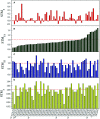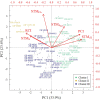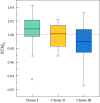Potential Short-Term Memory Induction as a Promising Method for Increasing Drought Tolerance in Sweetpotato Crop Wild Relatives [ Ipomoea series Batatas (Choisy) D. F. Austin]
- PMID: 33013990
- PMCID: PMC7494806
- DOI: 10.3389/fpls.2020.567507
Potential Short-Term Memory Induction as a Promising Method for Increasing Drought Tolerance in Sweetpotato Crop Wild Relatives [ Ipomoea series Batatas (Choisy) D. F. Austin]
Abstract
Crop wild relatives of sweetpotato [Ipomoea series Batatas (Choisy) D. F. Austin] are a group of species with potential for use in crop improvement programs seeking to breed for drought tolerance. Stress memory in this group could enhance these species' physiological response to drought, though no studies have yet been conducted in this area. In this pot experiment, drought tolerance, determined using secondary traits, was tested in 59 sweetpotato crop wild relative accessions using potential short-term memory induction. For this purpose, accessions were subjected to two treatments, i) non-priming: full irrigation (up to field capacity, 0.32 w/w) from transplanting to harvest and ii) priming: full irrigation from transplanting to flowering onset (FO) followed by a priming process from FO to harvest. The priming process consisted of three water restriction periods of increasing length (8, 11, and 14 days) followed each by a recovery period of 14 days with full irrigation. Potential stress memory induction was calculated for each accession based on ecophysiological indicators such as senescence, foliar area, leaf-minus-air temperature, and leaf 13C discrimination. Based on total biomass production, resilience and production capacity were calculated per accession to evaluate drought tolerance. Increase in foliar area, efficient leaf thermoregulation, improvement of leaf photosynthetic performance, and delayed senescence were identified in 23.7, 28.8, 50.8, and 81.4% of the total number of accessions, respectively. It was observed that under a severe drought scenario, a resilient response included more long-lived green leaf area while a productive response was related to optimized leaf thermoregulation and gas exchange. Our preliminary results suggest that I. triloba and I. trifida have the potential to improve sweetpotato resilience in dry environments and should be included in introgression breeding programs of this crop. Furthermore, I. splendor-sylvae, I. ramosissima, I. tiliacea, and wild I. batatas were the most productive species studied but given the genetic barriers to interspecific hybridization between these species and sweetpotato, we suggest that further genetic and metabolic studies be conducted on them. Finally, this study proposes a promising method for improving drought tolerance based on potential stress-memory induction, which is applicable both for wild species and crops.
Keywords: 13C discrimination; Batatas complex; drought stress memory; foliar area; leaf temperature; senescence delay.
Copyright © 2020 Guerrero-Zurita, Ramírez, Rinza, Ninanya, Blas and Heider.
Figures





Similar articles
-
Distributions, ex situ conservation priorities, and genetic resource potential of crop wild relatives of sweetpotato [Ipomoea batatas (L.) Lam., I. series Batatas].Front Plant Sci. 2015 Apr 21;6:251. doi: 10.3389/fpls.2015.00251. eCollection 2015. Front Plant Sci. 2015. PMID: 25954286 Free PMC article.
-
[Effects of nitrogen fertilizer reduction management on photosynthesis and chlorophyll fluorescence characteristics of sweetpotato].Ying Yong Sheng Tai Xue Bao. 2019 Apr;30(4):1253-1260. doi: 10.13287/j.1001-9332.201904.012. Ying Yong Sheng Tai Xue Bao. 2019. PMID: 30994286 Chinese.
-
Transcriptome-Based WGCNA Analysis Reveals the Mechanism of Drought Resistance Differences in Sweetpotato (Ipomoea batatas (L.) Lam.).Int J Mol Sci. 2023 Sep 21;24(18):14398. doi: 10.3390/ijms241814398. Int J Mol Sci. 2023. PMID: 37762701 Free PMC article.
-
A Dual Strategy of Breeding for Drought Tolerance and Introducing Drought-Tolerant, Underutilized Crops into Production Systems to Enhance Their Resilience to Water Deficiency.Plants (Basel). 2020 Sep 24;9(10):1263. doi: 10.3390/plants9101263. Plants (Basel). 2020. PMID: 32987964 Free PMC article. Review.
-
Cryopreservation of sweetpotato (Ipomoea batatas) and its pathogen eradication by cryotherapy.Biotechnol Adv. 2011 Jan-Feb;29(1):84-93. doi: 10.1016/j.biotechadv.2010.09.002. Epub 2010 Sep 16. Biotechnol Adv. 2011. PMID: 20851757 Review.
Cited by
-
Genome-Wide Identification and Analysis of NAC Transcription Factor Family in Two Diploid Wild Relatives of Cultivated Sweet Potato Uncovers Potential NAC Genes Related to Drought Tolerance.Front Genet. 2021 Nov 24;12:744220. doi: 10.3389/fgene.021.744220. eCollection 2021. Front Genet. 2021. PMID: 34899836 Free PMC article.
-
Conditioned soils reveal plant-selected microbial communities that impact plant drought response.Sci Rep. 2021 Oct 27;11(1):21153. doi: 10.1038/s41598-021-00593-z. Sci Rep. 2021. PMID: 34707132 Free PMC article.
References
-
- Agili S., Nyende B. (2012). Selection, yield evaluation, drought tolerance indices of orange-flesh Sweet potato (Ipomoea batatas (L.) Lam.) hybrid clone. J. Nutr. Food Sci. 02, 1–8. 10.4172/2155-9600.1000138 - DOI
-
- Ahmed M., Qadeer U., Ahmed Z., II, Hassan F. (2016). Improvement of wheat (Triticum aestivum) drought tolerance by seed priming with silicon. Arch. Agron. Soil Sci. 62, 299–315. 10.1080/03650340.2015.1048235 - DOI
-
- Andrade M., II, Naico A., Ricardo J., Eyzaguirre R., Makunde G. S., Ortiz R., et al. (2016). Genotype × environment interaction and selection for drought adaptation in sweetpotato (Ipomoea batatas [L.] Lam.) in Mozambique. Euphytica 209, 261–280. 10.1007/s10681-016-1684-4 - DOI
-
- Austin D. F., Jarret R. L., Johnson R. W. (1993). Ipomoea gracilis R. Brown (Convolvulaceae) and its allies. Bull. Torrey Bot. Club. 120, 49–59. 10.2307/2996663 - DOI
LinkOut - more resources
Full Text Sources

